
Discover Your Lot
Determining type of lot you are starting with is a great way to find the most appropriate lot design option(s). Browse and select from lot types below to learn more. Answer the quiz ( ![]() button ) to narrow down.
button ) to narrow down.
Are you having difficulty determining which lot type you are starting with? Remember to reach out to someone with experience you trust in your neighborhood. You can always call 313-294-LOTS for additional assistance.
Quiz
Forest Patch

Forest Patch Example
A Forest Patch is a lot that is on its way to becoming a forest. Forest Patches have woody growth — or small trees and shrubs—growing throughout the lot. Trees growing on the lot are at least 12 feet tall. If well managed, Forest Patches can become an amenity within the neighborhood, cleaning the air, providing shade, soaking up rainfall and snowmelt, and providing habitat. Conversely, if you wish to clear a Forest Patch and install a site design from the Field Guide, the woody debris from a Forest Patch could be good material to compost or to chip into mulch and use on your lot.
-
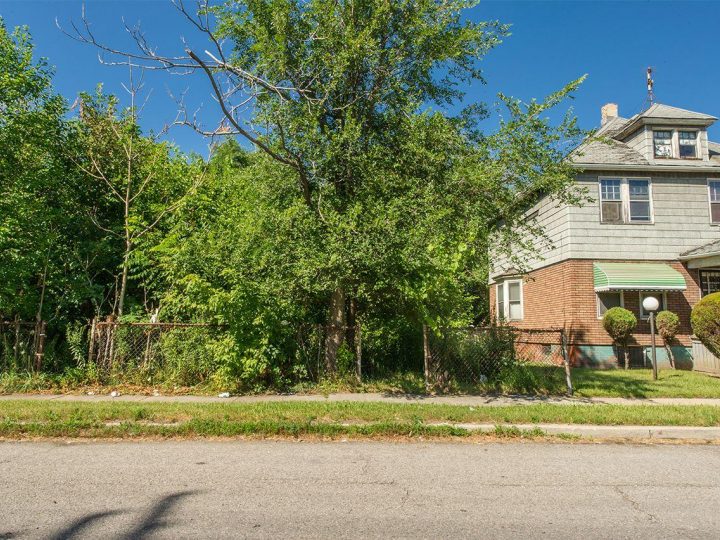

Photo © Detroit Future City
Forest Patch Example
A Forest Patch is a lot that is on its way to becoming a forest. Forest Patches have woody growth — or small trees and shrubs—growing throughout the lot. Trees growing on the lot are at least 12 feet tall. If well managed, Forest Patches can become an amenity within the neighborhood, cleaning the air, providing shade, soaking up rainfall and snowmelt, and providing habitat. Conversely, if you wish to clear a Forest Patch and install a site design from the Field Guide, the woody debris from a Forest Patch could be good material to compost or to chip into mulch and use on your lot.
-
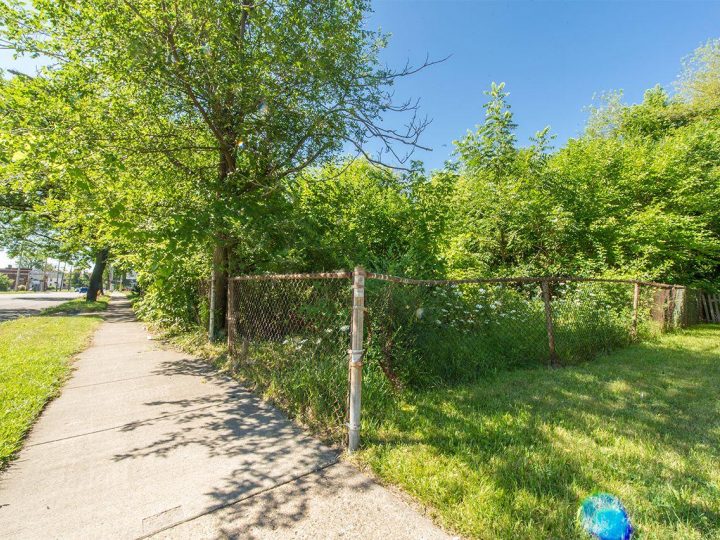

Photo © Detroit Future City
Forest Patch Example
A Forest Patch is a lot that is on its way to becoming a forest. Forest Patches have woody growth — or small trees and shrubs—growing throughout the lot. Trees growing on the lot are at least 12 feet tall. If well managed, Forest Patches can become an amenity within the neighborhood, cleaning the air, providing shade, soaking up rainfall and snowmelt, and providing habitat. Conversely, if you wish to clear a Forest Patch and install a site design from the Field Guide, the woody debris from a Forest Patch could be good material to compost or to chip into mulch and use on your lot.
-
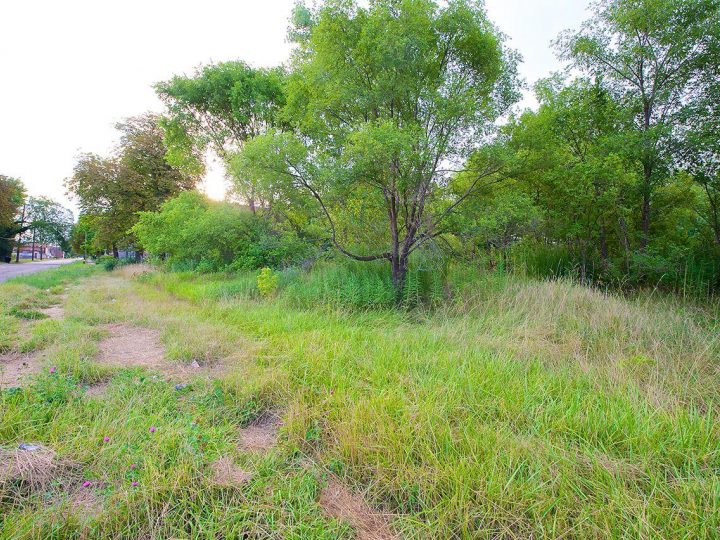

Photo © Detroit Future City
Forest Patch Example
A Forest Patch is a lot that is on its way to becoming a forest. Forest Patches have woody growth — or small trees and shrubs—growing throughout the lot. Trees growing on the lot are at least 12 feet tall. If well managed, Forest Patches can become an amenity within the neighborhood, cleaning the air, providing shade, soaking up rainfall and snowmelt, and providing habitat. Conversely, if you wish to clear a Forest Patch and install a site design from the Field Guide, the woody debris from a Forest Patch could be good material to compost or to chip into mulch and use on your lot.
-
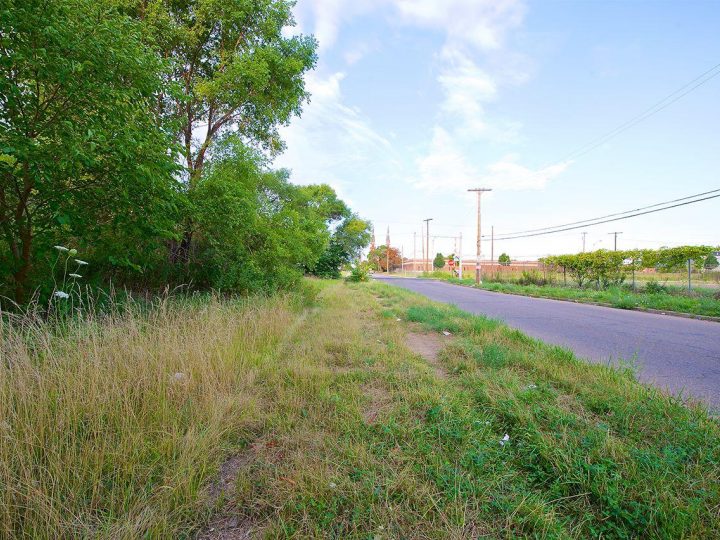

Photo © Detroit Future City
Forest Patch Example
A Forest Patch is a lot that is on its way to becoming a forest. Forest Patches have woody growth — or small trees and shrubs—growing throughout the lot. Trees growing on the lot are at least 12 feet tall. If well managed, Forest Patches can become an amenity within the neighborhood, cleaning the air, providing shade, soaking up rainfall and snowmelt, and providing habitat. Conversely, if you wish to clear a Forest Patch and install a site design from the Field Guide, the woody debris from a Forest Patch could be good material to compost or to chip into mulch and use on your lot.
Pangaea

Pangaea Example
A Pangaea is a lot with a cluster of trees growing only in the back third of the lot, with grasses growing underneath. This clump of trees runs across multiple lots, making the namesake ‘Pangaea’ or ‘super continent’ of trees on a single block. This lot type tends to occur on residential blocks that have more open lots than houses. Pangaea lots can act as the lungs of a neighborhood, are great for a Blendable strategy, as well as for adding more trees.
-
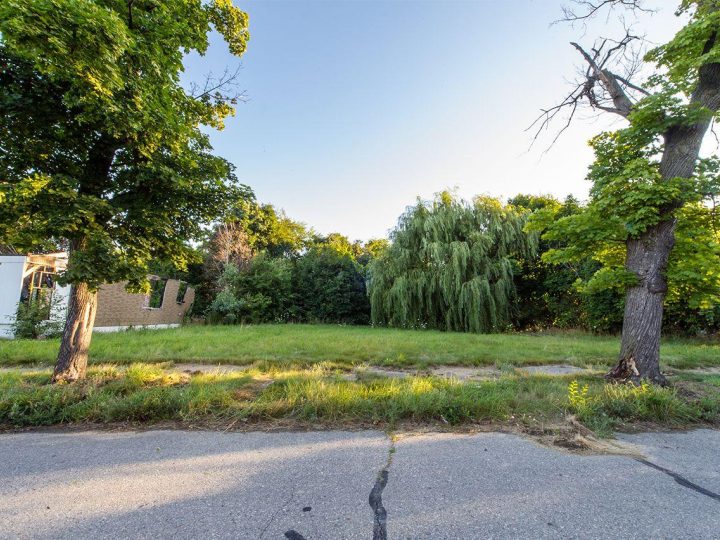

Photo © Detroit Future City
Pangaea Example
A Pangaea is a lot with a cluster of trees growing only in the back third of the lot, with grasses growing underneath. This clump of trees runs across multiple lots, making the namesake ‘Pangaea’ or ‘super continent’ of trees on a single block. This lot type tends to occur on residential blocks that have more open lots than houses. Pangaea lots can act as the lungs of a neighborhood, are great for a Blendable strategy, as well as for adding more trees.
-
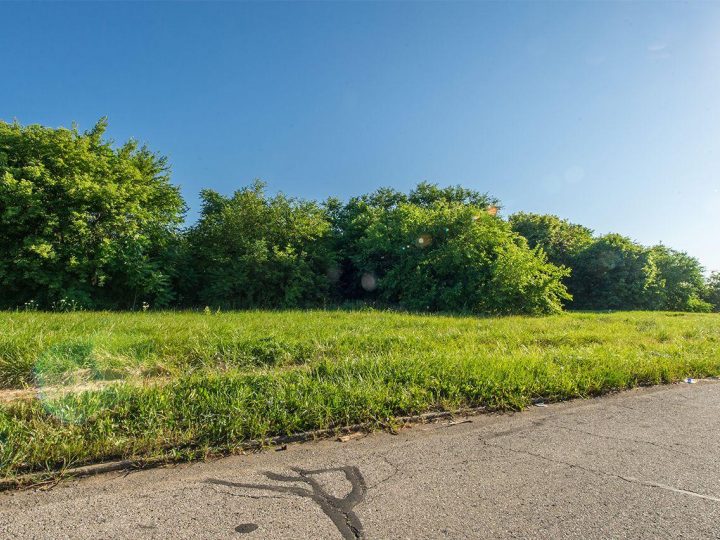

Photo © Detroit Future City
Pangaea Example
A Pangaea is a lot with a cluster of trees growing only in the back third of the lot, with grasses growing underneath. This clump of trees runs across multiple lots, making the namesake ‘Pangaea’ or ‘super continent’ of trees on a single block. This lot type tends to occur on residential blocks that have more open lots than houses. Pangaea lots can act as the lungs of a neighborhood, are great for a Blendable strategy, as well as for adding more trees.
-
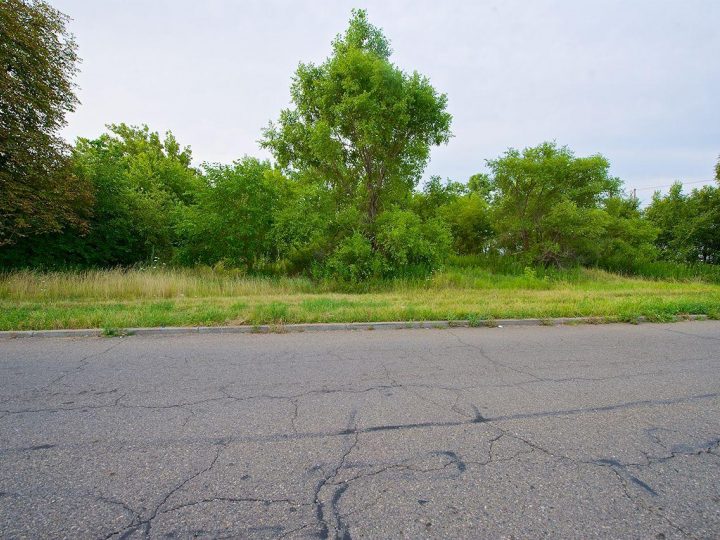

Photo © Detroit Future City
Pangaea Example
A Pangaea is a lot with a cluster of trees growing only in the back third of the lot, with grasses growing underneath. This clump of trees runs across multiple lots, making the namesake ‘Pangaea’ or ‘super continent’ of trees on a single block. This lot type tends to occur on residential blocks that have more open lots than houses. Pangaea lots can act as the lungs of a neighborhood, are great for a Blendable strategy, as well as for adding more trees.
-
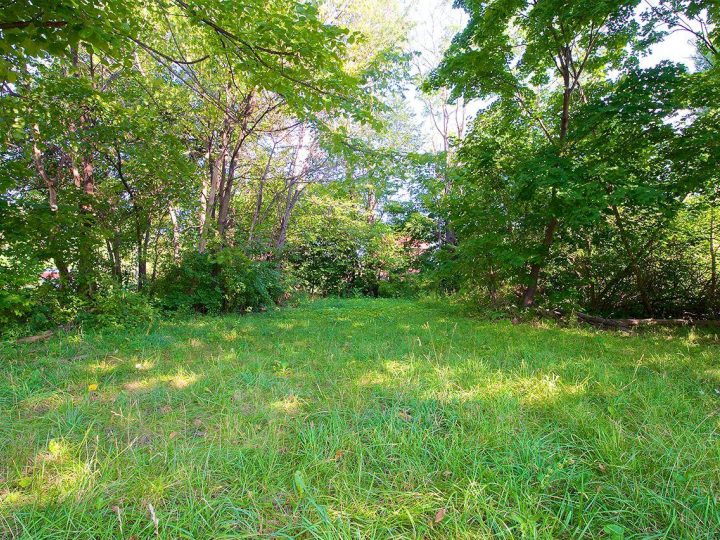

Photo © Detroit Future City
Pangaea Example
A Pangaea is a lot with a cluster of trees growing only in the back third of the lot, with grasses growing underneath. This clump of trees runs across multiple lots, making the namesake ‘Pangaea’ or ‘super continent’ of trees on a single block. This lot type tends to occur on residential blocks that have more open lots than houses. Pangaea lots can act as the lungs of a neighborhood, are great for a Blendable strategy, as well as for adding more trees.
Scrub Along the Fence

Scrub Along the Fence Example
A Scrub Along the Fence Lot has a collection of trees growing along the lot boundary, either along a fence, or in a line where the side lot fences used to be. These trees can be short and scrubby or quite tall. Linear elements (like fences) in our urban landscapes are good for collecting seeds that later sprout into plants, even if they are not wanted. Many—but not all—of the trees growing on this lot type might be volunteer species, or plants which have planted themselves. You have the choice of what to keep and what to remove. In general, Scrub Along the Fence lots will require a bit of extra pruning, to clear back the unwanted parts of these ‘tree lineups’ if you wish to create or preserve clear viewing lines. On the upside, the extra debris from this is great to compost or to chip into mulch and use on your lot. If you decide to keep your scrub, gentle shade might be yours for the having.
-
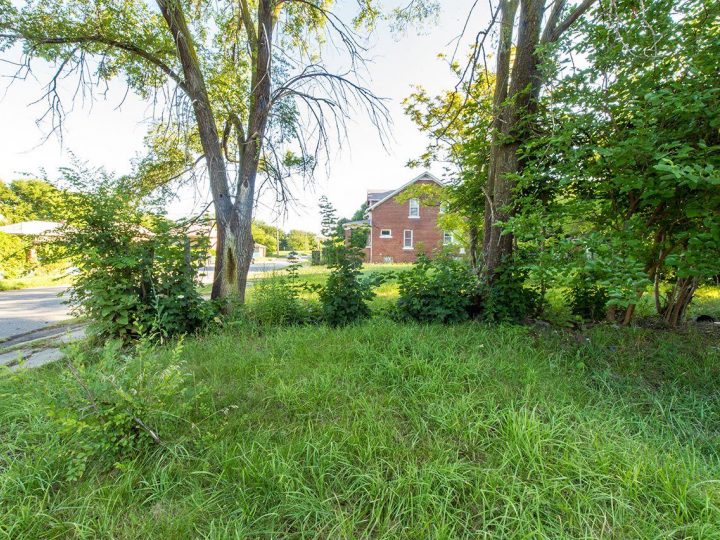

Photo © Detroit Future City
Scrub Along the Fence Example
A Scrub Along the Fence Lot has a collection of trees growing along the lot boundary, either along a fence, or in a line where the side lot fences used to be. These trees can be short and scrubby or quite tall. Linear elements (like fences) in our urban landscapes are good for collecting seeds that later sprout into plants, even if they are not wanted. Many—but not all—of the trees growing on this lot type might be volunteer species, or plants which have planted themselves. You have the choice of what to keep and what to remove. In general, Scrub Along the Fence lots will require a bit of extra pruning, to clear back the unwanted parts of these ‘tree lineups’ if you wish to create or preserve clear viewing lines. On the upside, the extra debris from this is great to compost or to chip into mulch and use on your lot. If you decide to keep your scrub, gentle shade might be yours for the having.
-
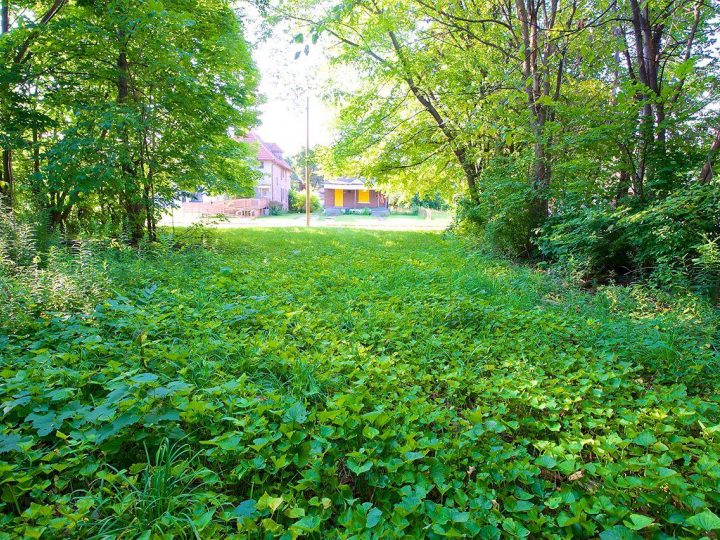

Photo © Detroit Future City
Scrub Along the Fence Example
A Scrub Along the Fence Lot has a collection of trees growing along the lot boundary, either along a fence, or in a line where the side lot fences used to be. These trees can be short and scrubby or quite tall. Linear elements (like fences) in our urban landscapes are good for collecting seeds that later sprout into plants, even if they are not wanted. Many—but not all—of the trees growing on this lot type might be volunteer species, or plants which have planted themselves. You have the choice of what to keep and what to remove. In general, Scrub Along the Fence lots will require a bit of extra pruning, to clear back the unwanted parts of these ‘tree lineups’ if you wish to create or preserve clear viewing lines. On the upside, the extra debris from this is great to compost or to chip into mulch and use on your lot. If you decide to keep your scrub, gentle shade might be yours for the having.
-


Photo © Detroit Future City
Scrub Along the Fence Example
A Scrub Along the Fence Lot has a collection of trees growing along the lot boundary, either along a fence, or in a line where the side lot fences used to be. These trees can be short and scrubby or quite tall. Linear elements (like fences) in our urban landscapes are good for collecting seeds that later sprout into plants, even if they are not wanted. Many—but not all—of the trees growing on this lot type might be volunteer species, or plants which have planted themselves. You have the choice of what to keep and what to remove. In general, Scrub Along the Fence lots will require a bit of extra pruning, to clear back the unwanted parts of these ‘tree lineups’ if you wish to create or preserve clear viewing lines. On the upside, the extra debris from this is great to compost or to chip into mulch and use on your lot. If you decide to keep your scrub, gentle shade might be yours for the having.
-
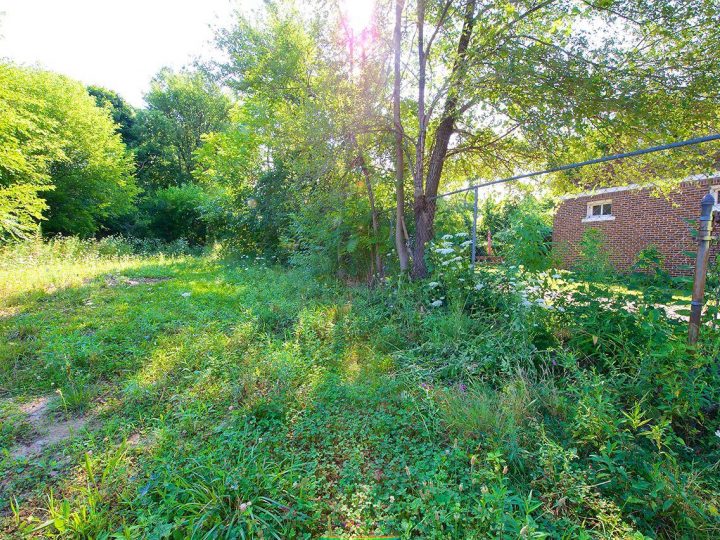

Photo © Detroit Future City
Scrub Along the Fence Example
A Scrub Along the Fence Lot has a collection of trees growing along the lot boundary, either along a fence, or in a line where the side lot fences used to be. These trees can be short and scrubby or quite tall. Linear elements (like fences) in our urban landscapes are good for collecting seeds that later sprout into plants, even if they are not wanted. Many—but not all—of the trees growing on this lot type might be volunteer species, or plants which have planted themselves. You have the choice of what to keep and what to remove. In general, Scrub Along the Fence lots will require a bit of extra pruning, to clear back the unwanted parts of these ‘tree lineups’ if you wish to create or preserve clear viewing lines. On the upside, the extra debris from this is great to compost or to chip into mulch and use on your lot. If you decide to keep your scrub, gentle shade might be yours for the having.
Happy Lawn

Happy Lawn Example
A Happy Lawn is a lot that has only grasses growing on it. The grasses may be short or tall. A Happy Lawn has a thick mane of hair, making it difficult to see the ground. Woody plants, such as small trees and shrubs, are not growing in scattered spots across the Happy Lawn. Happy Lawns are well-established and probably have been in place for several years. There is little to no shade on a Happy Lawn.
-
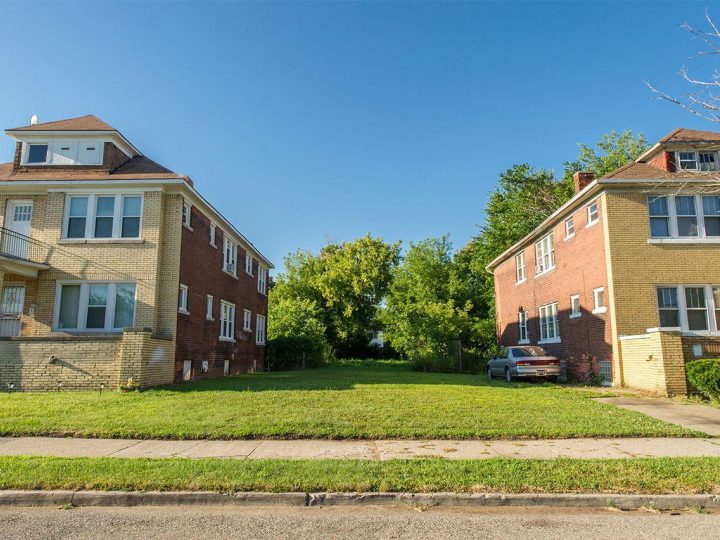

Photo © Detroit Future City
Happy Lawn Example
A Happy Lawn is a lot that has only grasses growing on it. The grasses may be short or tall. A Happy Lawn has a thick mane of hair, making it difficult to see the ground. Woody plants, such as small trees and shrubs, are not growing in scattered spots across the Happy Lawn. Happy Lawns are well-established and probably have been in place for several years. There is little to no shade on a Happy Lawn.
-
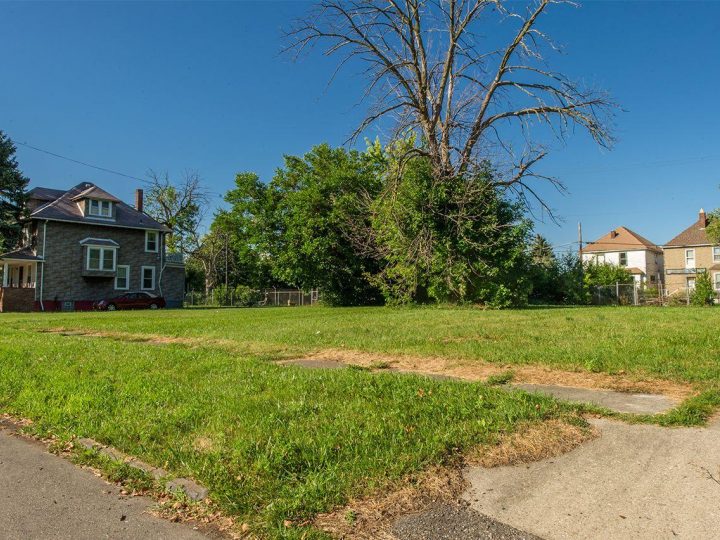

Photo © Detroit Future City
Happy Lawn Example
A Happy Lawn is a lot that has only grasses growing on it. The grasses may be short or tall. A Happy Lawn has a thick mane of hair, making it difficult to see the ground. Woody plants, such as small trees and shrubs, are not growing in scattered spots across the Happy Lawn. Happy Lawns are well-established and probably have been in place for several years. There is little to no shade on a Happy Lawn.
-
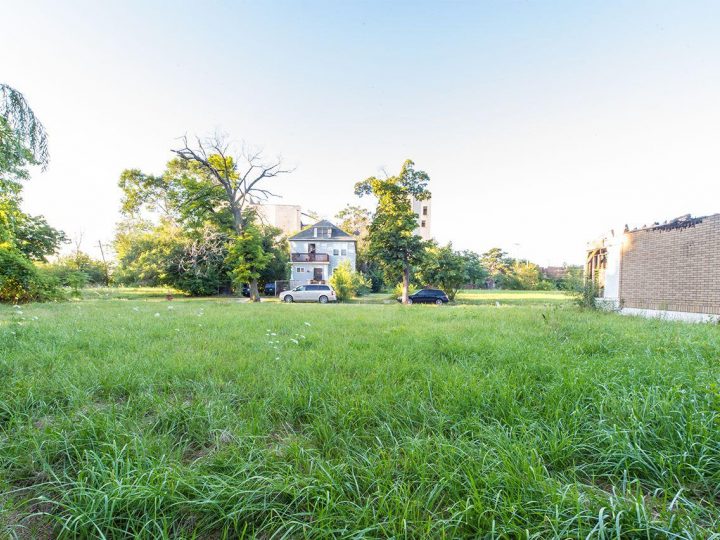

Photo © Detroit Future City
Happy Lawn Example
A Happy Lawn is a lot that has only grasses growing on it. The grasses may be short or tall. A Happy Lawn has a thick mane of hair, making it difficult to see the ground. Woody plants, such as small trees and shrubs, are not growing in scattered spots across the Happy Lawn. Happy Lawns are well-established and probably have been in place for several years. There is little to no shade on a Happy Lawn.
-
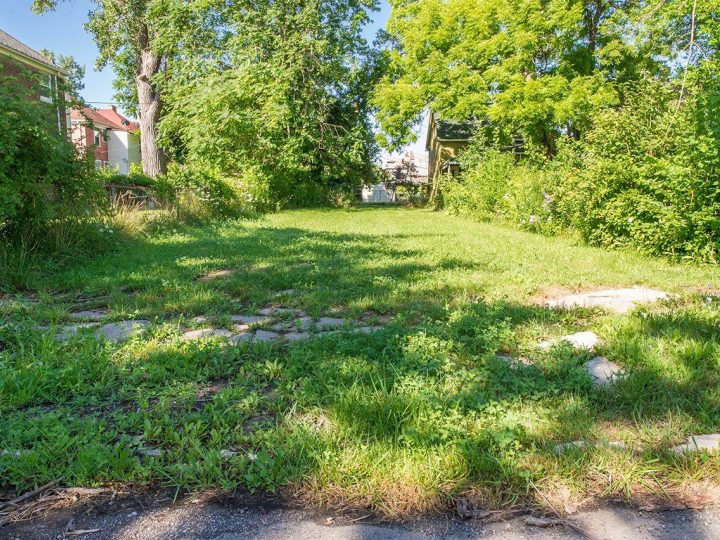

Photo © Detroit Future City
Happy Lawn Example
A Happy Lawn is a lot that has only grasses growing on it. The grasses may be short or tall. A Happy Lawn has a thick mane of hair, making it difficult to see the ground. Woody plants, such as small trees and shrubs, are not growing in scattered spots across the Happy Lawn. Happy Lawns are well-established and probably have been in place for several years. There is little to no shade on a Happy Lawn.
Hustling Lawn

Hustling Lawn Example
A Hustling Lawn is a lawn on its way. The somewhat scruffy mix of plants mostly covers the ground—more than half of the lot is covered—but the plants don’t look or feel entirely like grasses.
The mix of species in a Hustling Lawn might not be limited to grasses—there can be other plants like wildflowers or weeds. Hustling Lawns are not as sparse as a Bald Lot but not as thick as a Happy Lawn. Depending on the mix of species growing in a Hustling Lawn, it is possible to guesstimate whether your soils are low on certain nutrients. A good test: if you were going on a picnic, you might need to double up your blanket in order to be comfortable on a freshly cut Hustling Lawn.
-
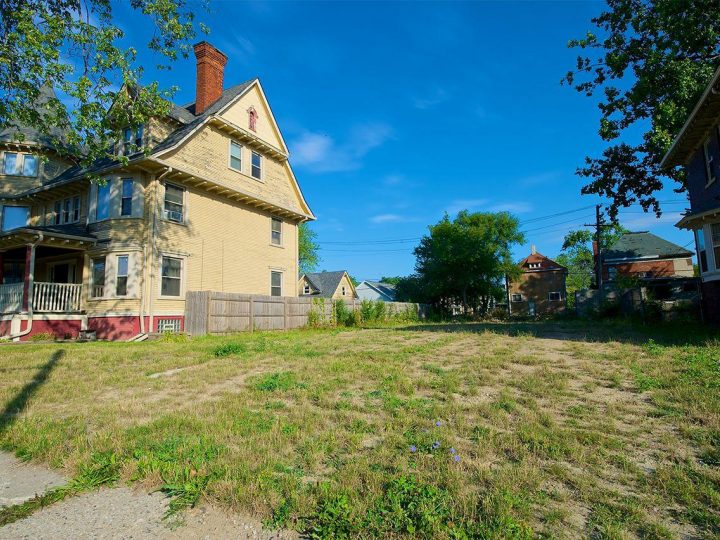

Photo © Detroit Future City
Hustling Lawn Example
A Hustling Lawn is a lawn on its way. The somewhat scruffy mix of plants mostly covers the ground—more than half of the lot is covered—but the plants don’t look or feel entirely like grasses.
The mix of species in a Hustling Lawn might not be limited to grasses—there can be other plants like wildflowers or weeds. Hustling Lawns are not as sparse as a Bald Lot but not as thick as a Happy Lawn. Depending on the mix of species growing in a Hustling Lawn, it is possible to guesstimate whether your soils are low on certain nutrients. A good test: if you were going on a picnic, you might need to double up your blanket in order to be comfortable on a freshly cut Hustling Lawn.
-
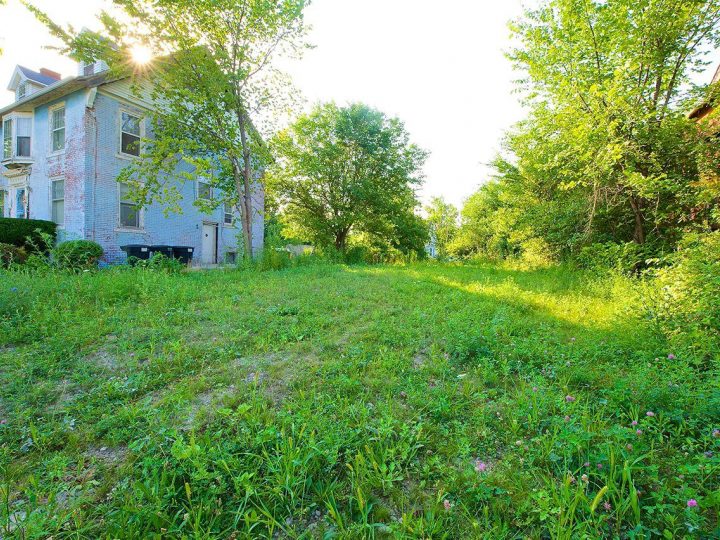

Photo © Detroit Future City
Hustling Lawn Example
A Hustling Lawn is a lawn on its way. The somewhat scruffy mix of plants mostly covers the ground—more than half of the lot is covered—but the plants don’t look or feel entirely like grasses.
The mix of species in a Hustling Lawn might not be limited to grasses—there can be other plants like wildflowers or weeds. Hustling Lawns are not as sparse as a Bald Lot but not as thick as a Happy Lawn. Depending on the mix of species growing in a Hustling Lawn, it is possible to guesstimate whether your soils are low on certain nutrients. A good test: if you were going on a picnic, you might need to double up your blanket in order to be comfortable on a freshly cut Hustling Lawn.
-
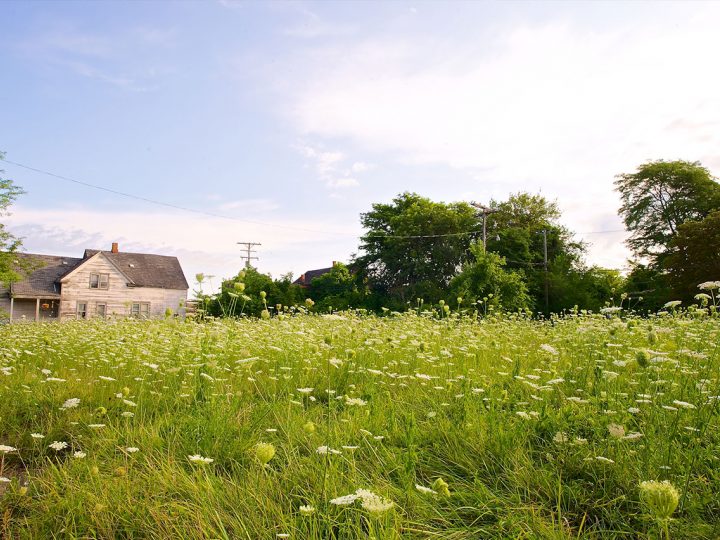

Photo © Detroit Future City
Hustling Lawn Example
A Hustling Lawn is a lawn on its way. The somewhat scruffy mix of plants mostly covers the ground—more than half of the lot is covered—but the plants don’t look or feel entirely like grasses.
The mix of species in a Hustling Lawn might not be limited to grasses—there can be other plants like wildflowers or weeds. Hustling Lawns are not as sparse as a Bald Lot but not as thick as a Happy Lawn. Depending on the mix of species growing in a Hustling Lawn, it is possible to guesstimate whether your soils are low on certain nutrients. A good test: if you were going on a picnic, you might need to double up your blanket in order to be comfortable on a freshly cut Hustling Lawn.
-
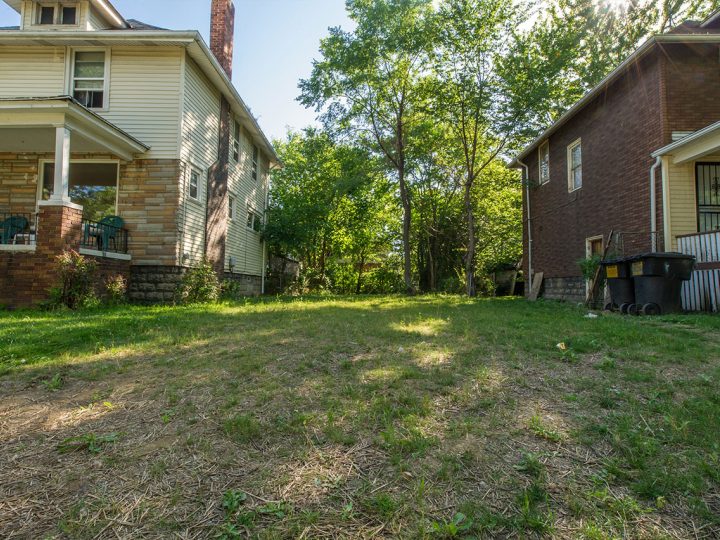

Hustling Lawn Example
A Hustling Lawn is a lawn on its way. The somewhat scruffy mix of plants mostly covers the ground—more than half of the lot is covered—but the plants don’t look or feel entirely like grasses.
The mix of species in a Hustling Lawn might not be limited to grasses—there can be other plants like wildflowers or weeds. Hustling Lawns are not as sparse as a Bald Lot but not as thick as a Happy Lawn. Depending on the mix of species growing in a Hustling Lawn, it is possible to guesstimate whether your soils are low on certain nutrients. A good test: if you were going on a picnic, you might need to double up your blanket in order to be comfortable on a freshly cut Hustling Lawn.
Bigger Street Trees

Bigger Street Trees Example
Healthy street trees are part of a healthy neighborhood—and we’ve given lots with Bigger Street Trees out front their own Lot Type. A lot with Bigger Street Trees has at least one healthy street tree with a diameter of one foot or greater. A street tree is a tree planted in the right-of-way, or the area between the sidewalk and the street. With a larger street tree out front, your lot will likely do better with a design selected for shade or partial shade, or with a design that places more emphasis on the center or the alley side of your lot. The Field Guide recommends preserving healthy large trees on every lot, even if it means making adjustments to the lot design you are considering.
-
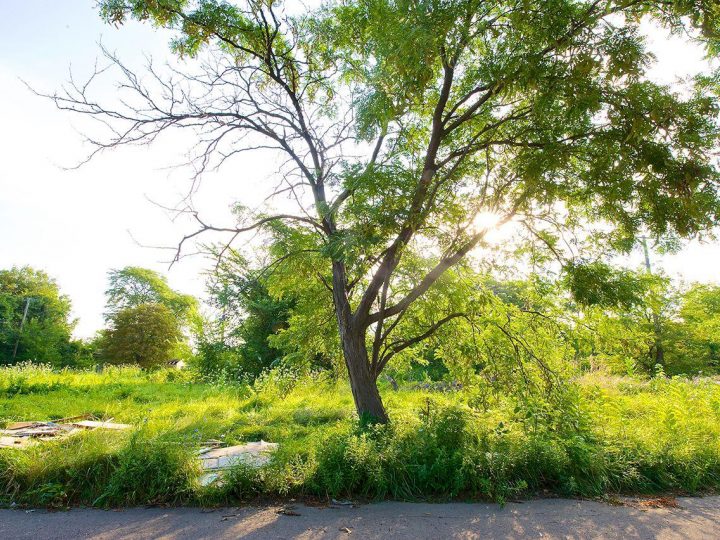

Photo © Detroit Future City
Bigger Street Trees Example
Healthy street trees are part of a healthy neighborhood—and we’ve given lots with Bigger Street Trees out front their own Lot Type. A lot with Bigger Street Trees has at least one healthy street tree with a diameter of one foot or greater. A street tree is a tree planted in the right-of-way, or the area between the sidewalk and the street. With a larger street tree out front, your lot will likely do better with a design selected for shade or partial shade, or with a design that places more emphasis on the center or the alley side of your lot. The Field Guide recommends preserving healthy large trees on every lot, even if it means making adjustments to the lot design you are considering.
-


Photo © Detroit Future City
Bigger Street Trees Example
Healthy street trees are part of a healthy neighborhood—and we’ve given lots with Bigger Street Trees out front their own Lot Type. A lot with Bigger Street Trees has at least one healthy street tree with a diameter of one foot or greater. A street tree is a tree planted in the right-of-way, or the area between the sidewalk and the street. With a larger street tree out front, your lot will likely do better with a design selected for shade or partial shade, or with a design that places more emphasis on the center or the alley side of your lot. The Field Guide recommends preserving healthy large trees on every lot, even if it means making adjustments to the lot design you are considering.
-
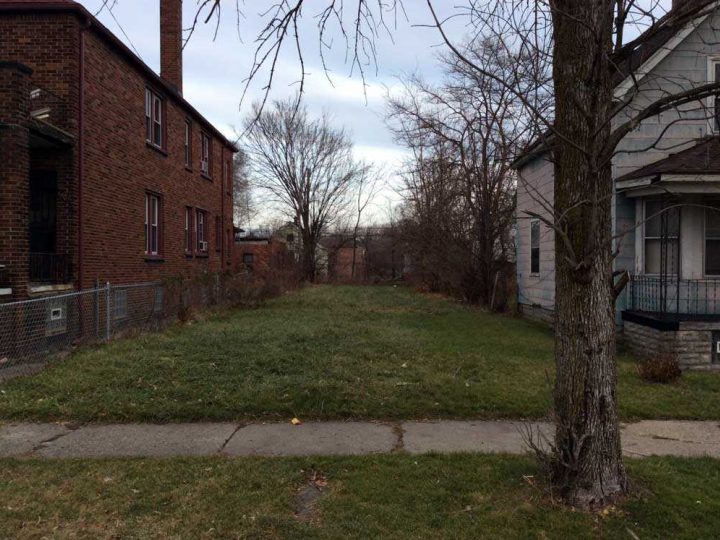

Photo © Detroit Future City
Bigger Street Trees Example
Healthy street trees are part of a healthy neighborhood—and we’ve given lots with Bigger Street Trees out front their own Lot Type. A lot with Bigger Street Trees has at least one healthy street tree with a diameter of one foot or greater. A street tree is a tree planted in the right-of-way, or the area between the sidewalk and the street. With a larger street tree out front, your lot will likely do better with a design selected for shade or partial shade, or with a design that places more emphasis on the center or the alley side of your lot. The Field Guide recommends preserving healthy large trees on every lot, even if it means making adjustments to the lot design you are considering.
-
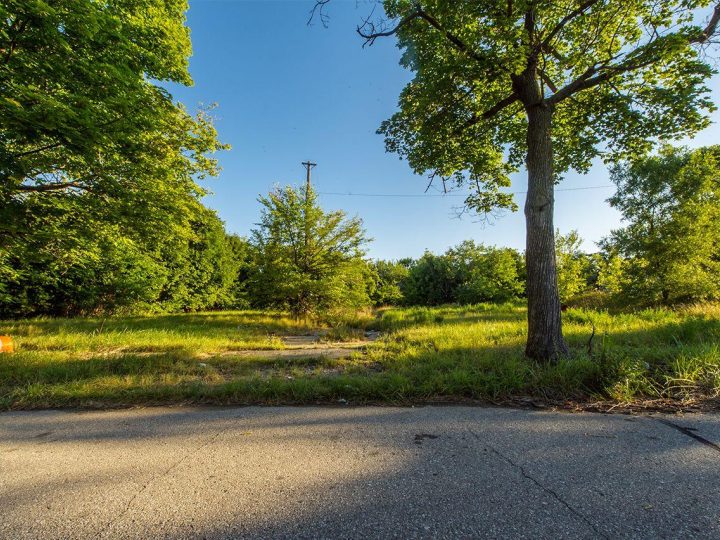

Photo © Detroit Future City
Bigger Street Trees Example
Healthy street trees are part of a healthy neighborhood—and we’ve given lots with Bigger Street Trees out front their own Lot Type. A lot with Bigger Street Trees has at least one healthy street tree with a diameter of one foot or greater. A street tree is a tree planted in the right-of-way, or the area between the sidewalk and the street. With a larger street tree out front, your lot will likely do better with a design selected for shade or partial shade, or with a design that places more emphasis on the center or the alley side of your lot. The Field Guide recommends preserving healthy large trees on every lot, even if it means making adjustments to the lot design you are considering.
Fresh Demo

Fresh Demo Example
A Fresh Demo lot is one where a building has recently been removed. Fresh Demos are recent, and require the least amount of preparation of the lot types. This lot type will be relatively level, have very little (unwanted) plant growth occurring and will also be topped off with a few inches of high (nutrient) quality soils, which is currently required as part of the demolition site finishing process.
-
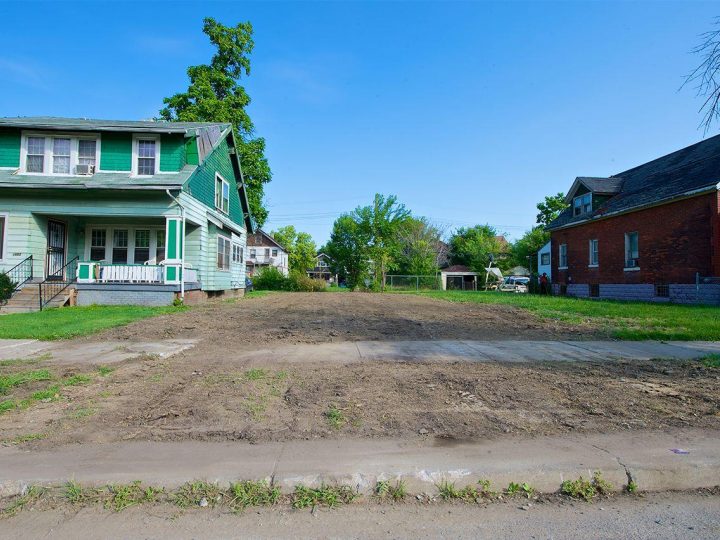

Photo © Detroit Future City
Fresh Demo Example
A Fresh Demo lot is one where a building has recently been removed. Fresh Demos are recent, and require the least amount of preparation of the lot types. This lot type will be relatively level, have very little (unwanted) plant growth occurring and will also be topped off with a few inches of high (nutrient) quality soils, which is currently required as part of the demolition site finishing process.
-
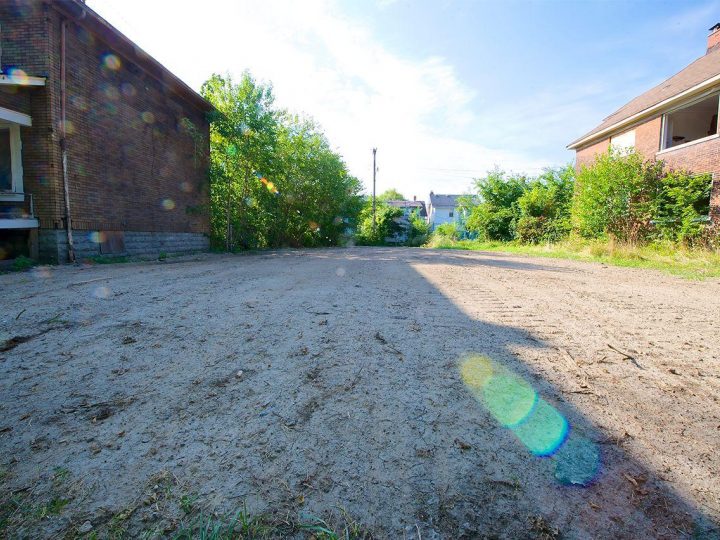

Photo © Detroit Future City
Fresh Demo Example
A Fresh Demo lot is one where a building has recently been removed. Fresh Demos are recent, and require the least amount of preparation of the lot types. This lot type will be relatively level, have very little (unwanted) plant growth occurring and will also be topped off with a few inches of high (nutrient) quality soils, which is currently required as part of the demolition site finishing process.
-
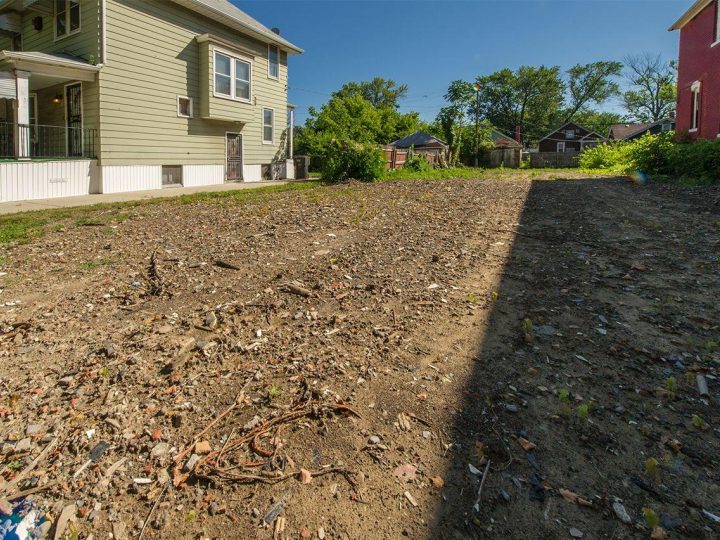

Photo © Detroit Future City
Fresh Demo Example
A Fresh Demo lot is one where a building has recently been removed. Fresh Demos are recent, and require the least amount of preparation of the lot types. This lot type will be relatively level, have very little (unwanted) plant growth occurring and will also be topped off with a few inches of high (nutrient) quality soils, which is currently required as part of the demolition site finishing process.
-
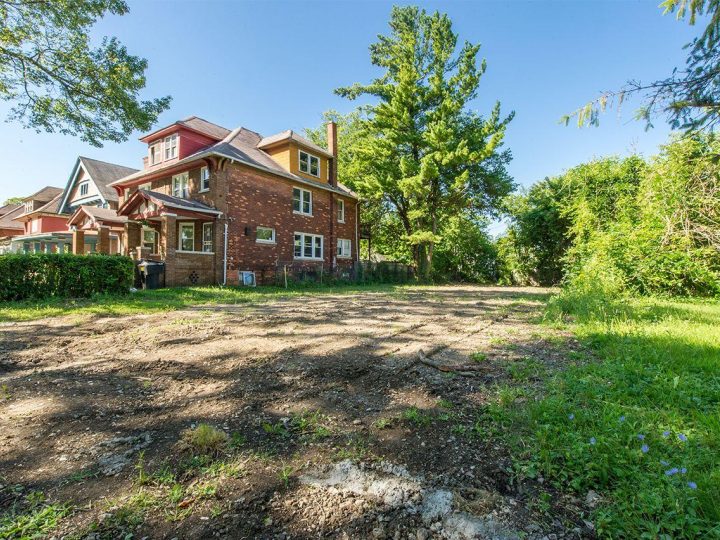

Photo © Detroit Future City
Fresh Demo Example
A Fresh Demo lot is one where a building has recently been removed. Fresh Demos are recent, and require the least amount of preparation of the lot types. This lot type will be relatively level, have very little (unwanted) plant growth occurring and will also be topped off with a few inches of high (nutrient) quality soils, which is currently required as part of the demolition site finishing process.
Bald

Bald Example
A Bald Lot is a lot with at least 50% of the ground bare, or only dirt. This includes lots where patchy grasses are beginning to appear, like a green “five o’clock shadow.” Bald Lots show us that plants are having a difficult time growing roots on them. This usually means that a bald lot is not allowing water to soak in. Bald Lots are great to start with—there’s less stuff to clear up off the top. Much of your work with a Bald Lot might involve making soils healthier, to ensure that plants can grow, and that water can better soak into your lot.
-
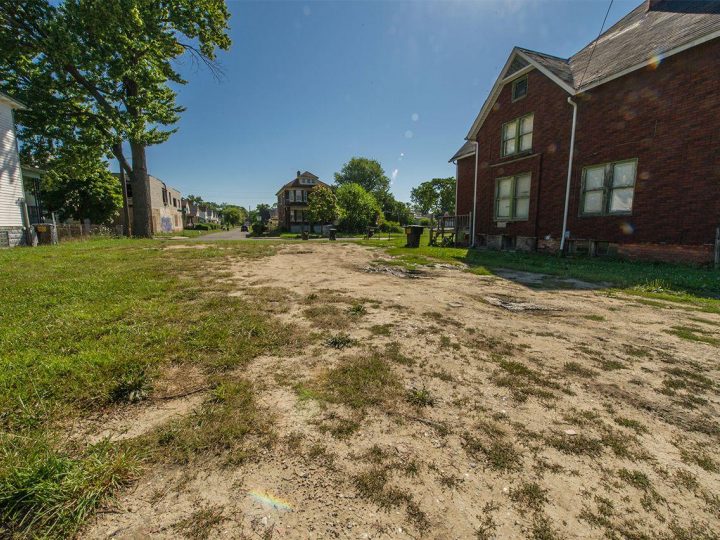

Photo © Detroit Future City
Bald Example
A Bald Lot is a lot with at least 50% of the ground bare, or only dirt. This includes lots where patchy grasses are beginning to appear, like a green “five o’clock shadow.” Bald Lots show us that plants are having a difficult time growing roots on them. This usually means that a bald lot is not allowing water to soak in. Bald Lots are great to start with—there’s less stuff to clear up off the top. Much of your work with a Bald Lot might involve making soils healthier, to ensure that plants can grow, and that water can better soak into your lot.
-
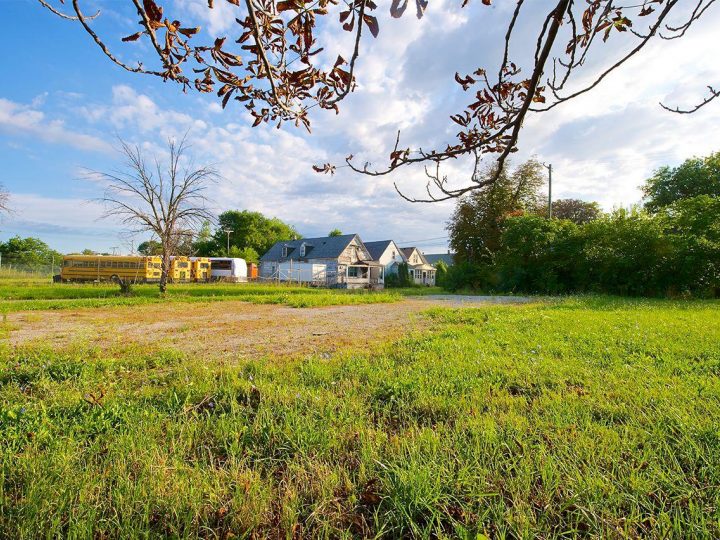

Photo © Detroit Future City
Bald Example
A Bald Lot is a lot with at least 50% of the ground bare, or only dirt. This includes lots where patchy grasses are beginning to appear, like a green “five o’clock shadow.” Bald Lots show us that plants are having a difficult time growing roots on them. This usually means that a bald lot is not allowing water to soak in. Bald Lots are great to start with—there’s less stuff to clear up off the top. Much of your work with a Bald Lot might involve making soils healthier, to ensure that plants can grow, and that water can better soak into your lot.
-
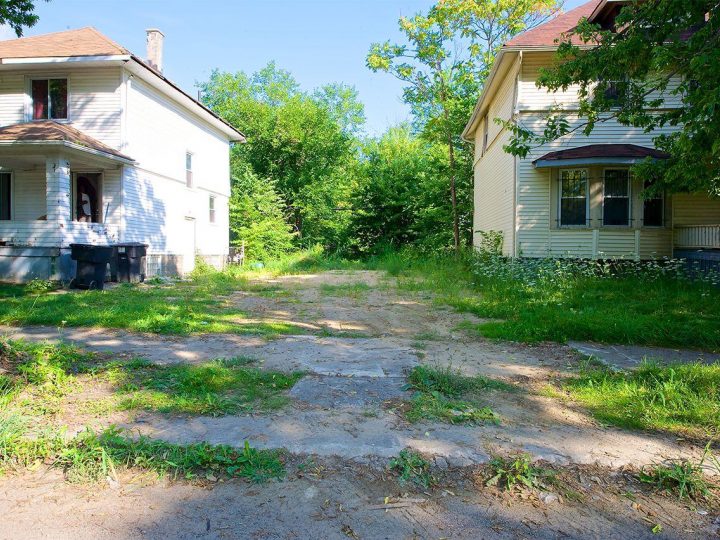

Photo © Detroit Future City
Bald Example
A Bald Lot is a lot with at least 50% of the ground bare, or only dirt. This includes lots where patchy grasses are beginning to appear, like a green “five o’clock shadow.” Bald Lots show us that plants are having a difficult time growing roots on them. This usually means that a bald lot is not allowing water to soak in. Bald Lots are great to start with—there’s less stuff to clear up off the top. Much of your work with a Bald Lot might involve making soils healthier, to ensure that plants can grow, and that water can better soak into your lot.
-


Photo © Detroit Future City
Bald Example
A Bald Lot is a lot with at least 50% of the ground bare, or only dirt. This includes lots where patchy grasses are beginning to appear, like a green “five o’clock shadow.” Bald Lots show us that plants are having a difficult time growing roots on them. This usually means that a bald lot is not allowing water to soak in. Bald Lots are great to start with—there’s less stuff to clear up off the top. Much of your work with a Bald Lot might involve making soils healthier, to ensure that plants can grow, and that water can better soak into your lot.
Basement in Place

Basement in Place Example
A Basement in Place Lot is a lot where there is a visible difference in the plants and activity above ground where the basement of a house either used to be, or still might be hiding underground. Basement in Place lots might have Phragmites, the tall, common reed, growing in a tight cluster within the basement footprint. The lot might be slightly raised where the basement once was, or there could be visible debris in the form of concrete and masonry at or just below the surface. This area could be bald, while the rest of the lot is covered with plants and grasses. Due to the underground debris, Basement in Place lots limit the range of designs that will work best on your lot without significant excavation.
-
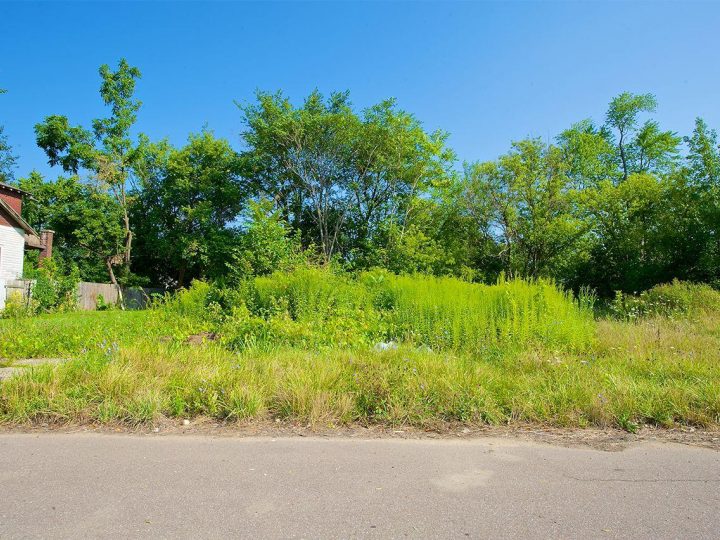

Photo © Detroit Future City
Basement in Place Example
A Basement in Place Lot is a lot where there is a visible difference in the plants and activity above ground where the basement of a house either used to be, or still might be hiding underground. Basement in Place lots might have Phragmites, the tall, common reed, growing in a tight cluster within the basement footprint. The lot might be slightly raised where the basement once was, or there could be visible debris in the form of concrete and masonry at or just below the surface. This area could be bald, while the rest of the lot is covered with plants and grasses. Due to the underground debris, Basement in Place lots limit the range of designs that will work best on your lot without significant excavation.
-


Photo © Detroit Future City
Basement in Place Example
A Basement in Place Lot is a lot where there is a visible difference in the plants and activity above ground where the basement of a house either used to be, or still might be hiding underground. Basement in Place lots might have Phragmites, the tall, common reed, growing in a tight cluster within the basement footprint. The lot might be slightly raised where the basement once was, or there could be visible debris in the form of concrete and masonry at or just below the surface. This area could be bald, while the rest of the lot is covered with plants and grasses. Due to the underground debris, Basement in Place lots limit the range of designs that will work best on your lot without significant excavation.
-
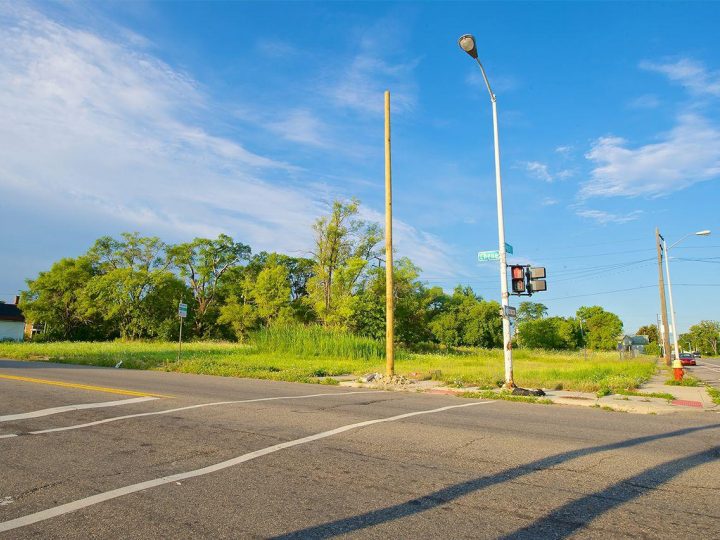

Photo © Detroit Future City
Basement in Place Example
A Basement in Place Lot is a lot where there is a visible difference in the plants and activity above ground where the basement of a house either used to be, or still might be hiding underground. Basement in Place lots might have Phragmites, the tall, common reed, growing in a tight cluster within the basement footprint. The lot might be slightly raised where the basement once was, or there could be visible debris in the form of concrete and masonry at or just below the surface. This area could be bald, while the rest of the lot is covered with plants and grasses. Due to the underground debris, Basement in Place lots limit the range of designs that will work best on your lot without significant excavation.
-


Photo © Detroit Future City
Basement in Place Example
A Basement in Place Lot is a lot where there is a visible difference in the plants and activity above ground where the basement of a house either used to be, or still might be hiding underground. Basement in Place lots might have Phragmites, the tall, common reed, growing in a tight cluster within the basement footprint. The lot might be slightly raised where the basement once was, or there could be visible debris in the form of concrete and masonry at or just below the surface. This area could be bald, while the rest of the lot is covered with plants and grasses. Due to the underground debris, Basement in Place lots limit the range of designs that will work best on your lot without significant excavation.
Mounded

Mounded Example
-
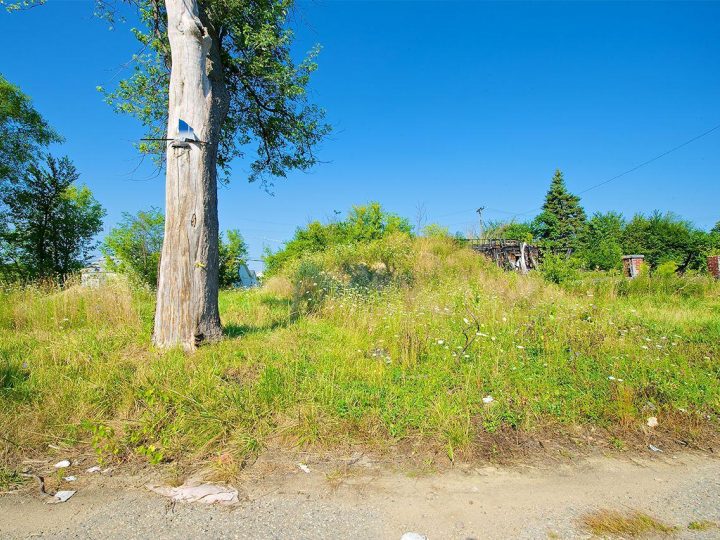

Photo © Detroit Future City
Mounded Example
-
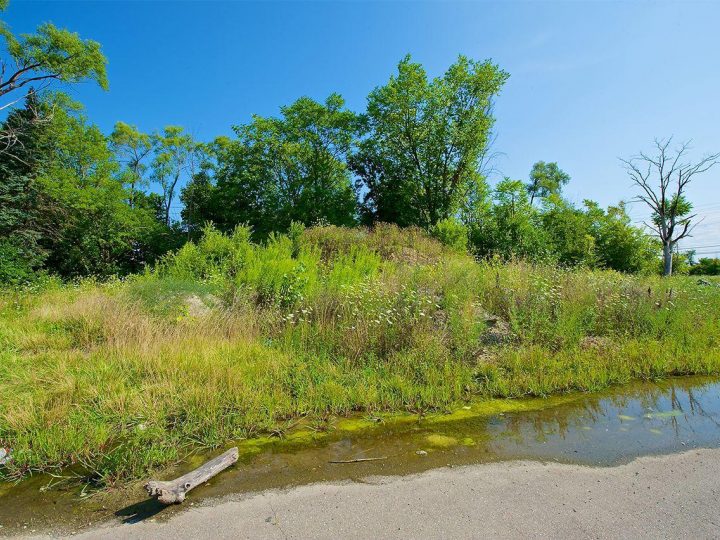

Photo © Detroit Future City
Mounded Example
-
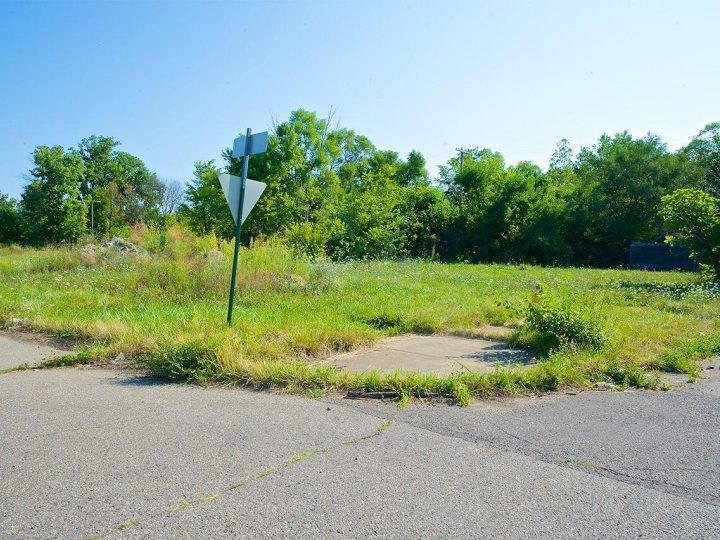

Photo © Detroit Future City
Mounded Example
-
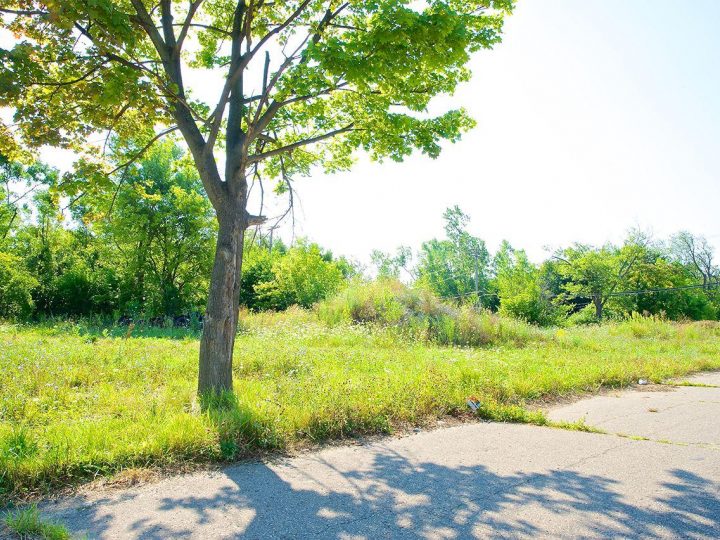

Photo © Detroit Future City
Mounded Example
Mixed Green

Mixed Green Example
A Mixed Green Lot is a lot with a little bit of everything—grasses, trees, maybe some remnant shrubs or even a mound or two. If you are looking to re-plant the majority of the lot’s surface area, the Mixed Green lot requires a greater amount of site preparation than most of the lot types, mostly because there are young woody plants like trees and shrubs growing within your lot, which will be more difficult to remove than just grasses alone. While it is possible that you will manage your Mixed Green Lot into a Forest Patch, it will take a long time horizon for this to occur, as the woody growth on this lot type is quite young. The Field Guide recommends preserving healthy large trees on every lot, even if it means making adjustments to the lot design you are considering.
-
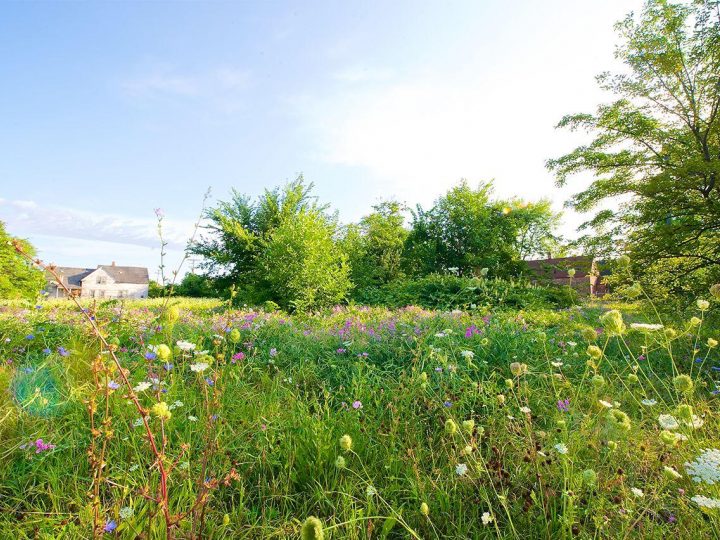

Photo © Detroit Future City
Mixed Green Example
A Mixed Green Lot is a lot with a little bit of everything—grasses, trees, maybe some remnant shrubs or even a mound or two. If you are looking to re-plant the majority of the lot’s surface area, the Mixed Green lot requires a greater amount of site preparation than most of the lot types, mostly because there are young woody plants like trees and shrubs growing within your lot, which will be more difficult to remove than just grasses alone. While it is possible that you will manage your Mixed Green Lot into a Forest Patch, it will take a long time horizon for this to occur, as the woody growth on this lot type is quite young. The Field Guide recommends preserving healthy large trees on every lot, even if it means making adjustments to the lot design you are considering.
-
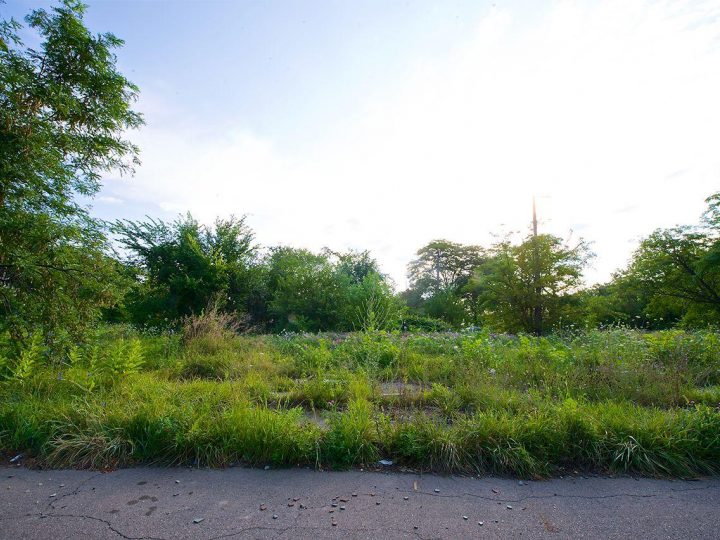

Photo © Detroit Future City
Mixed Green Example
A Mixed Green Lot is a lot with a little bit of everything—grasses, trees, maybe some remnant shrubs or even a mound or two. If you are looking to re-plant the majority of the lot’s surface area, the Mixed Green lot requires a greater amount of site preparation than most of the lot types, mostly because there are young woody plants like trees and shrubs growing within your lot, which will be more difficult to remove than just grasses alone. While it is possible that you will manage your Mixed Green Lot into a Forest Patch, it will take a long time horizon for this to occur, as the woody growth on this lot type is quite young. The Field Guide recommends preserving healthy large trees on every lot, even if it means making adjustments to the lot design you are considering.
-
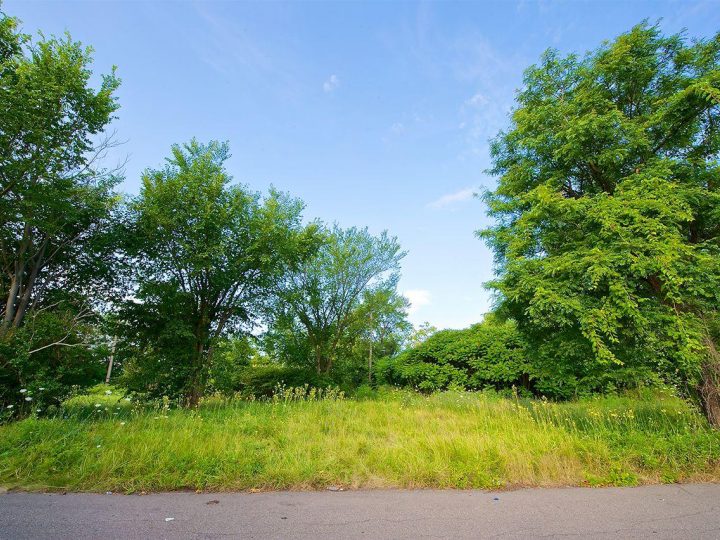

Photo © Detroit Future City
Mixed Green Example
A Mixed Green Lot is a lot with a little bit of everything—grasses, trees, maybe some remnant shrubs or even a mound or two. If you are looking to re-plant the majority of the lot’s surface area, the Mixed Green lot requires a greater amount of site preparation than most of the lot types, mostly because there are young woody plants like trees and shrubs growing within your lot, which will be more difficult to remove than just grasses alone. While it is possible that you will manage your Mixed Green Lot into a Forest Patch, it will take a long time horizon for this to occur, as the woody growth on this lot type is quite young. The Field Guide recommends preserving healthy large trees on every lot, even if it means making adjustments to the lot design you are considering.
-
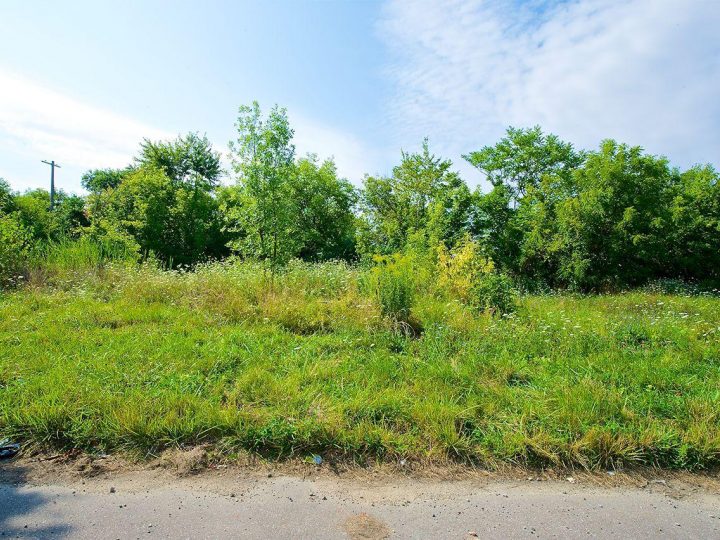

Photo © Detroit Future City
Mixed Green Example
A Mixed Green Lot is a lot with a little bit of everything—grasses, trees, maybe some remnant shrubs or even a mound or two. If you are looking to re-plant the majority of the lot’s surface area, the Mixed Green lot requires a greater amount of site preparation than most of the lot types, mostly because there are young woody plants like trees and shrubs growing within your lot, which will be more difficult to remove than just grasses alone. While it is possible that you will manage your Mixed Green Lot into a Forest Patch, it will take a long time horizon for this to occur, as the woody growth on this lot type is quite young. The Field Guide recommends preserving healthy large trees on every lot, even if it means making adjustments to the lot design you are considering.
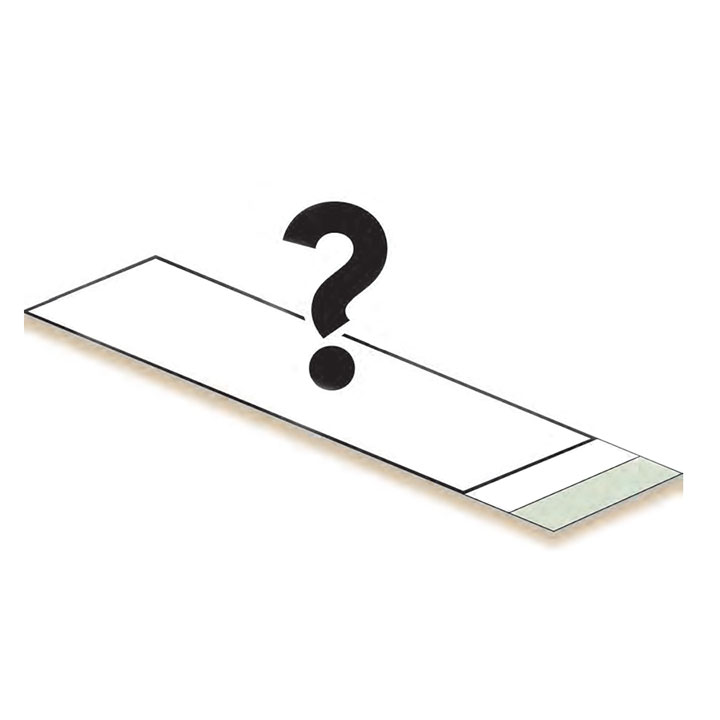
No lot types were found matching the selected filters.
Special Conditions
- Single
Singles are site designs intended for individual lots. If you are considering installing a site design from the Field Guide on a single lot, the best possible type of lot would be one with a building or with another side lot on at least one side of your lot. Detroit Future City sees opportunity in preserving larger, contiguous areas of open space for larger-scale land management strategies.
- Double
A Double is a lot design that works best on a double lot, or a lot with two contiguous lots that are both structure-free. The ideal double lot neighbors a house, store or an apartment building on at least one side. Detroit Future City sees opportunity in preserving larger, contiguous areas of open land for larger-scale land management strategies. ‘Doubles’ are designed for scattered, double-lot sites.
- Cupcake
Cupcake site designs are designs with lot ‘recipes’ that can be easily doubled or tripled. Twice the ingredients and twice the space will lead to easy, positive results! Many of the designs in the Field Guide can be doubled, but require a bit of extra consideration and tailoring as part of the doubling process. Cupcakes, however, easily translate into solutions for double and triple sized areas.
- Corner
A corner lot is located on a corner. Corner lots are highly visible and contribute to the visual identity of a neighborhood. In most of Detroit, the major storm drains are also located near corner lots, so it can be easier to build landscapes that connect back to the city’s water systems (i.e. Green Infrastructure) on a corner lot. Corners, like commercial lots, are often a unique shape.
- Splitting
Splitting site designs are well suited for a lot that two neighbors plan to share, or split. In addition to sharing the space through this style of lot design, you will need to approach the Wayne County Tax Assessor’s Office for assistance in legally splitting the lot into two individual parcels, or to join half of a lot with your existing lot.
- Commercial
Commercial site designs are intended for lots that are located along Detroit’s commercial corridors. Commercial lots share attributes that the Field Guide has anticipated from a design perspective. One is that these lots typically line transportation corridors, or roads where the legal speed limit is likely to be higher. Another is that there is a potential for prior contamination due to historic land use. These thoroughfares benefit from having a visual presence—although often open lots along commercial corridors previously have been used for parking. Another is that commercial lot dimensions vary greatly across the city, both their width and their depth. Commercial lots often have highly compacted, low nutrient soils that resemble gravel more than soil (again, due to the use for parking). A final trait of commercial lots is that they tend to have a different form of land use (for example, residential) behind them. It is important to note that commercial lots are guided by the City’s zoning requirements.











































